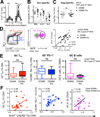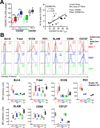Codelivery of Envelope Protein in Alum with MVA Vaccine Induces CXCR3-Biased CXCR5+ and CXCR5- CD4 T Cell Responses in Rhesus Macaques
- PMID: 26116502
- PMCID: PMC4506863
- DOI: 10.4049/jimmunol.1500083
Codelivery of Envelope Protein in Alum with MVA Vaccine Induces CXCR3-Biased CXCR5+ and CXCR5- CD4 T Cell Responses in Rhesus Macaques
Abstract
The goal of an HIV vaccine is to generate robust and durable protective Ab. Vital to this goal is the induction of CD4(+) T follicular helper (TFH) cells. However, very little is known about the TFH response to HIV vaccination and its relative contribution to magnitude and quality of vaccine-elicited Ab titers. In this study, we investigated these questions in the context of a DNA/modified vaccinia virus Ankara SIV vaccine with and without gp140 boost in aluminum hydroxide in rhesus macaques. In addition, we determined the frequency of vaccine-induced CD4(+) T cells coexpressing chemokine receptor, CXCR5 (facilitates migration to B cell follicles) in blood and whether these responses were representative of lymph node TFH responses. We show that booster modified vaccinia virus Ankara immunization induced a distinct and transient accumulation of proliferating CXCR5(+) and CXCR5(-) CD4 T cells in blood at day 7 postimmunization, and the frequency of the former but not the latter correlated with TFH and B cell responses in germinal centers of the lymph node. Interestingly, gp140 boost induced a skewing toward CXCR3 expression on germinal center TFH cells, which was strongly associated with longevity, avidity, and neutralization potential of vaccine-elicited Ab response. However, CXCR3(+) cells preferentially expressed the HIV coreceptor CCR5, and vaccine-induced CXCR3(+)CXCR5(+) cells showed a moderate positive association with peak viremia following SIV251 infection. Taken together, our findings demonstrate that vaccine regimens that elicit CXCR3-biased TFH cell responses favor Ab persistence and avidity but may predispose to higher acute viremia in the event of breakthrough infections.
Copyright © 2015 by The American Association of Immunologists, Inc.
Figures






Similar articles
-
Early T Follicular Helper Cell Responses and Germinal Center Reactions Are Associated with Viremia Control in Immunized Rhesus Macaques.J Virol. 2019 Feb 5;93(4):e01687-18. doi: 10.1128/JVI.01687-18. Print 2019 Feb 15. J Virol. 2019. PMID: 30463978 Free PMC article.
-
Induction of Th1-Biased T Follicular Helper (Tfh) Cells in Lymphoid Tissues during Chronic Simian Immunodeficiency Virus Infection Defines Functionally Distinct Germinal Center Tfh Cells.J Immunol. 2016 Sep 1;197(5):1832-42. doi: 10.4049/jimmunol.1600143. Epub 2016 Aug 1. J Immunol. 2016. PMID: 27481845 Free PMC article.
-
Persistent Simian Immunodeficiency Virus Infection Causes Ultimate Depletion of Follicular Th Cells in AIDS.J Immunol. 2015 Nov 1;195(9):4351-7. doi: 10.4049/jimmunol.1501273. Epub 2015 Sep 25. J Immunol. 2015. PMID: 26408660 Free PMC article.
-
Divergent Expression of CXCR5 and CCR5 on CD4+ T Cells and the Paradoxical Accumulation of T Follicular Helper Cells during HIV Infection.Front Immunol. 2017 May 12;8:495. doi: 10.3389/fimmu.2017.00495. eCollection 2017. Front Immunol. 2017. PMID: 28553284 Free PMC article. Review.
-
T follicular helper cells and HIV/SIV-specific antibody responses.Curr Opin HIV AIDS. 2014 May;9(3):235-41. doi: 10.1097/COH.0000000000000053. Curr Opin HIV AIDS. 2014. PMID: 24670319 Review.
Cited by
-
Clade C HIV-1 Envelope Vaccination Regimens Differ in Their Ability To Elicit Antibodies with Moderate Neutralization Breadth against Genetically Diverse Tier 2 HIV-1 Envelope Variants.J Virol. 2019 Mar 21;93(7):e01846-18. doi: 10.1128/JVI.01846-18. Print 2019 Apr 1. J Virol. 2019. PMID: 30651354 Free PMC article.
-
TFR Cells Express Functional CCR6 But It Is Dispensable for Their Development and Localization During Splenic Humoral Immune Responses.Front Immunol. 2022 Jun 22;13:873586. doi: 10.3389/fimmu.2022.873586. eCollection 2022. Front Immunol. 2022. PMID: 35812408 Free PMC article.
-
Immunogenicity and efficacy of DNA/MVA HIV vaccines in rhesus macaque models.Expert Rev Vaccines. 2017 Oct;16(10):973-985. doi: 10.1080/14760584.2017.1371594. Epub 2017 Sep 4. Expert Rev Vaccines. 2017. PMID: 28838267 Free PMC article. Review.
-
The Role of CD4+ T Follicular Helper Cells in HIV Infection: From the Germinal Center to the Periphery.Front Immunol. 2017 Jan 30;8:46. doi: 10.3389/fimmu.2017.00046. eCollection 2017. Front Immunol. 2017. PMID: 28194154 Free PMC article. Review.
-
Strong TH1-biased CD4 T cell responses are associated with diminished SIV vaccine efficacy.Sci Transl Med. 2019 Nov 20;11(519):eaav1800. doi: 10.1126/scitranslmed.aav1800. Sci Transl Med. 2019. PMID: 31748228 Free PMC article.
References
-
- Chan TD, Gatto D, Wood K, Camidge T, Basten A, Brink R. Antigen affinity controls rapid T-dependent antibody production by driving the expansion rather than the differentiation or extrafollicular migration of early plasmablasts. J Immunol. 2009;183:3139–3149. - PubMed
-
- Crotty S. Follicular helper CD4 T cells (TFH) Annual review of immunology. 2011;29:621–663. - PubMed
-
- Cyster JG. Shining a light on germinal center B cells. Cell. 2010;143:503–505. - PubMed
Publication types
MeSH terms
Substances
Grants and funding
LinkOut - more resources
Full Text Sources
Other Literature Sources
Research Materials

